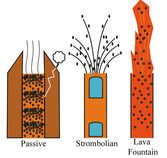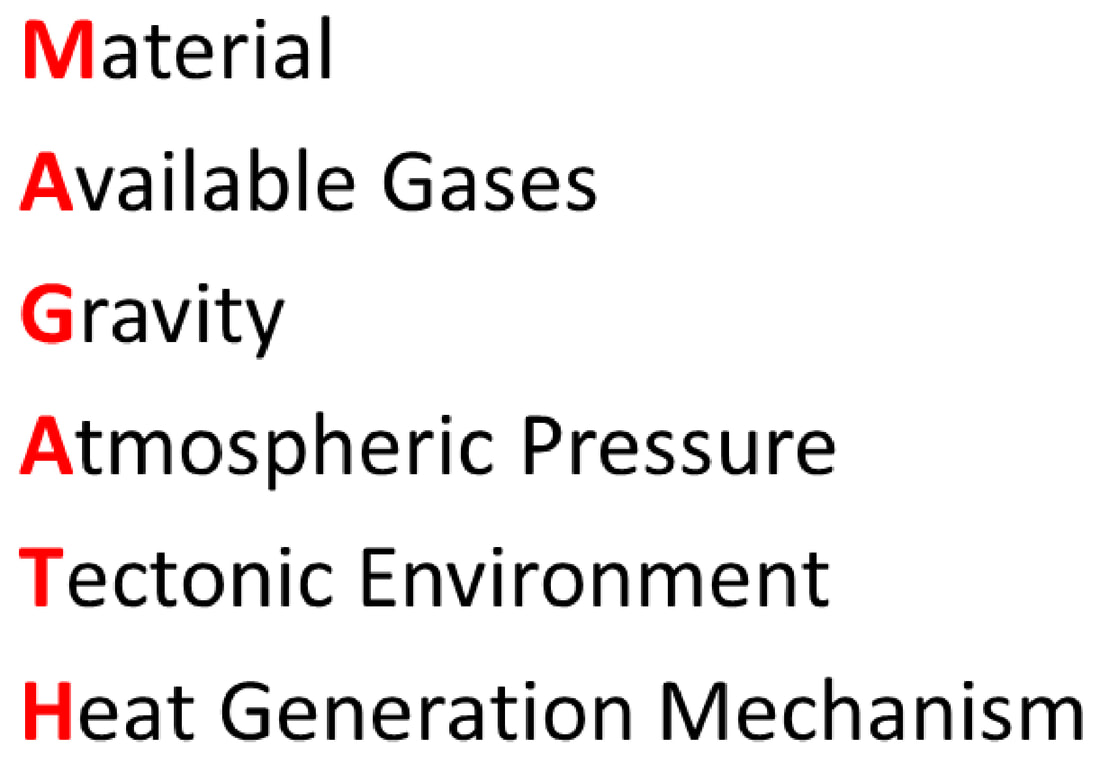|
I am always looking for ways of innovating my teaching and attempting to come up with new ideas to communicate the material and ideas to students. So here is one such idea which initially stemmed from some teaching I delivered on planetary volcanology but that I now use across my volcano teaching. The idea is an acronym 'MAGATH' which, when used, (maybe!) helps us to understand volcanic processes throughout the solar system, in terms of how the volcanic activity is generated and the volcanic products or phenomena which may then be produced, along with some of the major controls on volcanic behaviour. So here it is, MAGATH, and what each of the letters stands for:  Example basaltic styles of behaviour, smaller bubbles generating passive degassing and larger bubbles strombolian. Example basaltic styles of behaviour, smaller bubbles generating passive degassing and larger bubbles strombolian. M is for Material. Here we get to the crux of the matter straight away, not all volcanic activity has to be molten rock, indeed, there are several planetary bodies which exhibit ice-based volcanism. Within this we can also have significant variety of rock or type of ice. For example, on the Earth we have basalts, a low-viscosity rock when molten, which commonly exhibits low explosivity styles such as strombolian or lava flows OR we could have a rhyolitic magma which may present in far more explosive Plinian styles of behaviour. There are of course a large number of possible types of material, and nuances to this, but the first step is the understanding that these materials can vary greatly (and themselves have varying properties related to things like silica and crystal content) and can then subsequently effect the volcanic activity type or phenomena which occur. A is for Available Gases. The gases which are contained within magmas are one of the major drivers of explosive volcanic behaviour. Beyond this we can then begin to probe into what types of gas there are, the major constituents on Earth being water, carbon dioxide, and sulphur dioxide, amongst a number of other gases. These gases form bubbles within magmas, it is how these bubbles behave and interact within the conduit which can then lead to the variety of styles of activity that we see at the surface. If we were to take a basaltic magma and add a certain amount of gas to the mix, what style of activity would we see? If we had only enough gas to produce small millimetre sized bubbles we may produce passive degassing, if we were then to grow the size of bubbles in a basalt to metres in length we could generate strombolian activity. G is for Gravity. Have you ever seen the plumes of Io (a moon of Jupiter)? Gravity plays a role in their height and trajectories. How far will a lava flow travel? How high will an eruption column be? Gravity plays a key role in all such questions. Gravity also links very closely with the theme of the next letter A. A is for Atmospheric Pressure. A great example here is to compare the atmospheric pressure of Earth (around 101 kPa) to Venus (around 9300 kPa). Atmospheric pressure will effect the rate of exsolution of gases from a magma, this is the formation of bubbles as a magma rises to the surface. A higher surface pressure means that more bubbles can stay dissolved within the magma, and as gas is one of the major drivers of explosive behaviour this means that we need a higher gas content for magmas on Venus to generate explosive behaviour. Coupled with this, if any activity were to occur, the volcanic products, an eruption column for example, wouldn't reach the same height as on the Earth, this is directly related to the thickness of the atmosphere (which is related to the pressure). Another good example is comparing the trajectory or distance of a volcanic bomb, on the Earth a bomb is subject to a number of forces (air resistance, gravity etc.), at a location such as the Moon where there is little to no atmosphere AND where gravity is lower, a volcanic bomb could travel further. T is for Tectonic Environment. This one is key and is intrinsically linked with Plate Tectonics. Roughly speaking we can attribute certain styles of volcanism to certain tectonic environments (e.g., spreading margin, subduction zone, hot spot), we can then build an expectation of style of activity we may expect, so with a hot spot in an oceanic setting (oceanic crust) we may expect more basaltic style behaviour, such as the Hawaiian island chain, whereas at a subduction zone we may expect more explosive styles of behaviour perhaps related to the production of ashy eruption columns. H is for Heat Generation Mechanism. Volcanism or volcanic activity is, simply put, some form of surface evidence or product of the heating of material (see the link back to the first letter 'M', what material has been heated!). The question is then, what is the mechanism of heating? We can broadly narrow this down to two main mechanisms, the radioactive decay of isotopes and tidal forces. So, MAGATH aims to help students identify: the key factors which act to control style of volcanic activity, how the activity may behave in the atmosphere, and how it is generated. It can then become a framework to build other content around, as needed, and importantly these factors interact. And of course there are many complexities which effect volcanism beyond the examples given here, which are just a flavour. To delve into more I would have to write a book! There are already some great existing volcano books around for more detail and elaboration though. Anyhow, I hope this may be of use, after a quick google the other common use for 'MAGATH' is a German football manager, so all good on that front. I also think it is quite similar to the word 'magma' so could be easier to remember, who knows whether this is actually true or not! Comments are closed.
|
Archives
July 2023
|


 RSS Feed
RSS Feed